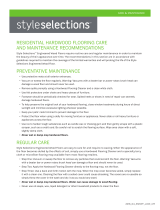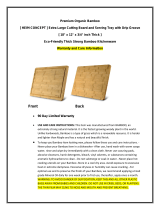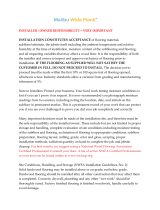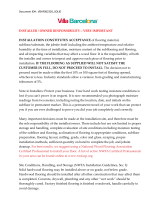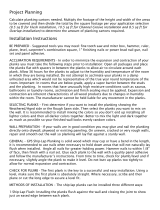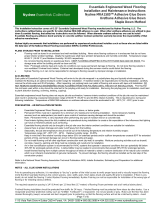Page is loading ...

LOCKING ENGINEERED
BAMBOO WOOD FLOORING
ITEM#
1357341
1357343
1357344
1357345
MODEL#
193101
193103
193104
193105
ATTACH YOUR RECEIPT HERE
ATTACH YOUR RECEIPT HERE
ATTACH YOUR RECEIPT HERE
1
Style selections is a registered trademark
of LF,LLC.All Rights Reserved.
TM
BM19132
10
10

Package Contents..............................................................................................................2
Safety Information..............................................................................................................
2
Preparation.........................................................................................................................3
Assembly or Installation Instructions.................................................................................
3
Operating Instructions........................................................................................................5
Warranty.............................................................................................................................
8
CAUTION
Vacuum or sweep regularly. Do not use vacuums with beater bar or power brush attached. They
could scratch the floor.
Use walk off mats in all exterior doorways.
High heels will cause damage to wood floors.
Keep pet’s nails trimmed.
Never slide heavy furniture or appliances across floor.
Clean up wet spills immediately with clean, dry cloth.
Never wet mop soaps, wax or other household cleaners on your wood floor.
Temperature and Humidity must be controlled in the space the floor is installed. Temperature
should be between 62-73 F (17-23 C). Relative humidity should remain between 35%-65%.
Gapping may occur if humidity drops below 30%.
2

3
Thoroughly examine the flooring prior to installation for grade, color, finish and quality.
Ensure adequate lighting for proper inspection. If flooring is not acceptable, do not install the floor.
Please contact the seller immediately and arrange for replacement. The NWFA states that up to 5%
of material may be culled for blemishes or defects without being considered defective. Please note
our products contain a standard pattern variation and installers should be working from multiple open
boxes to ensure boards are blended throughout. The manufacturer cannot accept responsibility for
installation of flooring with visible defects. Installation of this product warrants the acceptance by the
installer or owner for the quality of the material, as well as conditions in which the material is being
installed therein.
It is the Installer/Owner responsibility to ensure that the conditions are acceptable prior to the
installation of the hardwood floors. The manufacturer declines any and all problems associated with
the hardwood flooring that are related to or attributed to improper jobsite conditions. Any splits,
cracks, grain raising, checking, edge fracturing, splintering, cupping, crowning/peaking, warping,
twisting, expansion/contraction, buckling or chipping that occurs during or after the floor has been
installed and as a result of abuse, misuse, improper maintenance or care, exposure to excessive or
insufficient moisture, improper environmental conditions including excessive heat from radiant heat
systems are not covered under the manufacturer’s warranty. Prior to installation of any flooring, the
installer must ensure that the jobsite and subfloor meet the requirements of these installation instruc-
tions. All necessary accessories, including trim, must be present at the jobsite prior to beginning
installation. The manufacturer is not responsible for flooring failure resulting from unsatisfactory
jobsite and/or subfloor conditions. When purchasing flooring, per NWFA guidelines we recommend
adding 5%-15% to actual square footage needed for cutting allowance and to compensate for culled
material. It is acceptable, per the NWFA guidelines, that up to 5% of material be outside the range of
acceptance.
It shall be the responsibility of the Installer to document installation date, product SKU and Lot infor-
mation, duration of product acclimation, flooring moisture content, subfloor moisture content, site
relative humidity and site temperature. This information must be documented by the installer and a
copy provided to the property owner to ensure product warranty coverage.
TOOLS AND SUPPLIES NEEDED
Moisture Meter, Tape Measure, Pencil, Chalk Line, Hand Saw or Power Saw, Tapping Block, Crow
Bar or Pry Bar, Wood or Plastic Spacers(1/2 in), Hammer or Rubber Mallet, safety glasses, filter
mask, earplugs.
FOR GLUE-DOWN INSTALLATION, YOU WILL ALSO NEED: Premium Wood Flooring Adhesive,
Adhesive trowel (as recommended by adhesive manufacturer).
FOR NAIL-DOWN INSTALLATION, YOU WILL ALSO NEED: Manual or pneumatic 16-gauge floor
nailer OR 16-gauge narrow-crown stapler, 1 3/4 in or 2 in 16-gauge cleats or staples, Finish nailer
and/or Color-matching wood putty/filler.
JOBSITE & PRE-INSTALLATION GUIDELINES
Bamboo flooring should be one of the last items installed for any new construction or remodel proj-
ect. All Bamboo flooring must be installed per the manufacturers and NWFA installation guidelines.
All “wet” work – i.e. – paint, drywall, concrete, masonry, plumbing must be complete and dry prior
to the delivery of hardwood flooring
Gutters and downspouts should be in place and the exterior grade complete to allow for proper
drainage of water away from the building’s exterior perimeter.

4
HVAC should be on, operational and maintained between 60 – 80 degrees with a relative humidity
of 35%- 55% range a minimum of 5 days prior to delivery, during and after installation of the
flooring.
Test wood sub floors and wood flooring for moisture content using moisture meter recommended
for bamboo flooring, such as Lignomat SDM or comparable. Take readings of the subfloor –
minimum of 20 readings per 1000 sq. ft. and average the results. In most regions, a “dry” subfloor t
hat is ready to work on has a moisture content of 12% or less and the wood should be within 2%
for planks greater than 3 in wide and 4% for planks less than 3 in wide of the subfloor’s moisture
content. Please refer to the NWFA moisture content by area map for specific requirements.
Test the concrete subfloors moisture content by calcium chloride testing or by using an appropriate
moisture meter. The moisture content for concrete subfloors registered after a calcium chloride test
should not be greater than 3 pounds per 1000 square feet of area. If it exceeds these limits, DO
NOT install the flooring. Before moisture testing begins, the slab must be cured for a minimum of
30 days. The moisture vapor emission rate for concrete subfloors must not exceed 75% RH using
ASTM 2170 or 3 pounds per 1000.sq ft per 24 hours using Calcium Chloride test ASTM 1869. If
using a moisture meter, please refer to the recommended guidelines set forth for by that moisture
meters’ manufacturer.
Basements and crawl spaces must be dry. Use of a 6 mil black polyethylene is required to cover
100% of the crawl space earth. Crawl space clearance from ground to underside of joist to be no
less than 18” and perimeter vent spacing should be equal to 1.5% of the total square footage of
the crawl space area to provide cross ventilation in accordance with local regulations.
ALWAYS CHECK MOISTURE LEVELS BEFORE INSTALLING
Preparing and leveling the sub-floor:
1. The subfloor needs to be structurally sound; do not install over particle board. Please refer to
NWFA guidelines for sound substrate qualifications.
2. The sub-floor should be free of any surface defect. If it is not, fill gaps with a Portland-based
leveling cement (for concrete floors only) or sand/grind down any uneven areas. For wood floors,
use a wood leveling patch or skim coat as needed.
3. The sub-floor must be level and flat to 3/16 in (5mm) per 10’ radius or 1/8 in (3.2mm) per 6- foot
radius.
4. Any gaps in the sub-floor should not exceed 3/16 in (5mm).
5. Use flooring screws into floor joists if necessary, to minimize squeaks in subfloor.
6. The surface must be clean and free of any contaminants such as wax, paint, grease, dust, oil,
nails, staples, old adhesive, etc. and thoroughly swept and free of all debris.
7. For concrete installation, ensure that the concrete is not low-density (below 3000 psi) or gypsum
based.
8. Plywood must be CDX-rated at least 3/4 in thick. OSB must be 3/4 in, PS2 rated, and installed
sealed-side down.
9. Moisture content should not exceed 12% .
ACCLIMATION
Store this flooring at the installation area before installation to allow the flooring to acclimate and
adjust to room temperature and humidity.
Do not install the flooring until the moisture content of the subfloor where the flooring will be
installed is within 2% for planks greater than 3 in wide and 4% for planks less than 3 in wide from
the moisture content of the flooring.
If you do not allow the flooring sufficient time to acclimate and the moisture content of the flooring
exceeds that of the subfloor, the flooring will continue to contract after installation and gaps may
develop between the flooring. Likewise, if the moisture content of the flooring is less than that of
the subfloor, the flooring may expand and/or cupping may develop.

5
BLENDING OF CARTONS
To achieve a uniform appearance across the entire floor, we require that you open and work from a
minimum of four cartons at a time and lay out the flooring ahead of time. Be sure to mix the planks for
the best aesthetic appearance. Make certain the room is well lit to ensure color is consistent and that
any visual defects can be seen and removed prior to installation.
LAYOUT OF FLOORING
“Racking the Floor” is essential to achieve a random appearance. Start by cutting several boards in
random lengths, differing the lengths by at least six inches. As you continue working across the floor
remember to maintain a six-inch minimum space between the end joints.
Randomly install different lengths to avoid a patterned appearance. Never waste materials; the end
cuts from starter rows should be used at the opposite side of the room to complete rows or may be
used to start the next row.
EXPANSION SPACE
An expansion space of 1/2” must be left around the perimeter of the room and at all vertical obstruc-
tions. More or less spacing may be needed depending on the geographical region, interior climate,
and or time of the year. Your bamboo flooring WILL move/shrink/expand. This is a normal occurrence
of a natural product.
NAIL DOWN/STAPLE INSTALLATION INSTRUCTIONS
Step One - Establish a Starting Point
1. Remove any existing wall base, shoe molding, quarter round or doorway threshold.
2. Determine the direction of the floor joists – Run the flooring perpendicular (90°) to the floor joists.
Do not run flooring parallel to floor joists per NWFA Guidelines.
3. Prior to installing flooring, roll out 15 lb. felt or asphalt impregnated paper in the same direction of
the flooring. Overlap each row by 3 in to 4 in. This process will help to keep the floor clean and
help to retard moisture from below.
4. Establish a starting point. We recommend the longest exterior runningwall.
5. Measure the total width of the flooring (including the tongue), plus 1/2 in for expansion. Measure
out this distance in at least 2 places from the starting wall and 12 in from the corners. Then, snap
a chalk line parallel to the starting wall.
Step Two - Lay Out
1. Choose the longest and straightest boards and align the plank’s tongue with the working line. Cut
the last plank to the proper length leaving a 1/2 in from the end wall.
2. Top nail the boards into place approximately 6 in apart and 1 in from the back edge (groove side)
using a pneumatic nailer; Always use a nail set to sink the nail heads below the surface of the
flooring. Remember to fill the holes with matching wood putty/filler.
3. Continue to blind nail by hand each succeeding row until the nailer/stapler can be used to install
the flooring. It is critical to make sure the starting row is properly aligned and straight.
4. If necessary, we recommend pre-drilling pilot holes spaced 6 in to 8 in apart at a 45° angle along
the tongue and blind nail the plank. Be sure to countersink the nails with a nail set.
Step Three – Rack the Floor
1. Once the first four rows are in place, continue to lay out the planks. Remain working from at least f
our open cartons. Be sure to blend the planks and stagger the end joints a minimum of 6 in apart
to ensure a favorable appearance. Avoid H-Joint and other repeating patterns in the floor.

6
STEP FOUR - INSTALLATION OF FLOORING
1. Once the initial rows are in place, begin installing the planks using either a manual or pneumatic
nailer/stapler using 16-gauge cleats staples. Check to ensure the fastener is set to the proper
depth and angle buy adjusting the nailer/stapler shoes. Blind nail through the tongue using a
minimum 1 1/2 in-2 in staple or cleat; fasten the planks approximately 2 in to 3 in from the ends
and every 8 in apart with a minimum of 2 fasteners per plank.
2. Continue installing planks across the room and ending at the far wall using the manual or
pneumatic nailer/stapler and following the recommended nailing schedule. Remember, never
waste materials; the end cuts from starter rows should be used at the opposite side of the room to
complete rows or to start the next row. As you reach the far wall it may be necessary to blind nail
by hand until top nailing is required.
3. It may be necessary to rip the last row to allow for the 1/2 in expansion. If the last row is 1 in or
less glue the pieces to the last full uninstalled row and install them together. If needed, use a pry
bar or lever to fit the remaining rows tight to the installed planks.
4. Top nail the last 1-2 rows into place approximately 6 in apart and 1 in from the back edge(groove
side) using a pneumatic finish nailer. Always use a nail set to sink the nail heads below the surface
of the flooring. Remember to fill the holes with matching wood putty/filler.
SKIP TO STEP FIVE
GLUE-DOWN INSTALLATION INSTRUCTIONS
The manufacturer recommends the use of a low-VOC, premium, water-free flooring adhesive specifi-
cally recommended by the adhesive manufacturer for use with engineered or solid wood flooring.
Step One – Establish a Starting Point
1. Remove any existing wall base, shoe molding, quarter round or doorway threshold.
2. Determine the direction of the floor joists and run the flooring perpendicular(90°) to the floor joists.
Do not run flooring parallel to floor joists.
3. Flooring may be installed in any direction over a concrete slab.
4. Establish a starting point. We recommend the longest exterior running wall.
5. Measure the total wodth of the flooring(including the tongue),plus 1/2 in for expansion. Measure
out this distance in at least 2 places from the starting wall and 12 in from the corners. Snap a
chalk line parallel to the starting wall.
Step Two – Lay Out
1. Choose the longest and straightest boards and align the plank’s tongue with the working line.
Cut the last plank to the proper length leaving a 1/2 in from the end wall. Lay out three additional
rows, then move these rows away from the working area.
2. Spread enough adhesive to just cover the area of the first four rows of flooring using the
appropriate trowels and installation technique. Please refer to the adhesive manufacturer’s
instructions for application. Never use a “wet-lay” adhesive, as this could trap moisture under the
flooring, causing it to warp.
3. Place flooring onto adhesive, one row at a time, making sure that all joints are tight and parallel.
Be sure to use 100-150lb. weighted roller to ensure complete transfer of adhesive; always protect
the floor when using weighted roller.
4. Allow the adhesive to set per the adhesive manufacturer’s recommendation. It is critical to check
your work, making sure the starting row is properly aligned and straight.

Step Three – Rack the Floor
1. Once the first four rows are in place, continue to lay out the planks. Remain working from at least
four open cartons. Be sure to blend the planks and stagger the end joints a minimum of 6 in apart
to ensure a favorable appearance. Avoid H-Joint and other repeating patterns in the floor.
Step Four - Installation of Flooring
1. Trowel out a small working area of adhesive at a time. (approx. 3 ft or according to the adhesive
manufacturers recommendation). This ensures the glue remains workable and still has a tack.
Begin placing flooring onto adhesive, one row at a time, making sure that all joints are tight and
parallel.
2. When installing near a solid object or wall, leave a minimum of 1/2 in as required expansion
space.
3. It may be necessary to rip the last row to allow for the 1/2 in expansion. If the last row is 1 in or
less, glue the pieces to the last full uninstalled row and install them together. If needed, use a pry
bar to fit the remaining rows tight to the installed planks.
4. When installation is complete, use wedges or spacers to hold wood in place while adhesive dries.
Spacers may be removed after initial setting of adhesive to allow for normal expansion of wood.
5. Roll and cross-roll floor with a 100-150 lb. roller at the end of the installation to ensure proper
transfer of adhesive. Be sure the flooring is cleaned and completely free of any and all debris to
avoid damage.
6. Once you have completed laying the bamboo flooring, allow it to dry at least 24 hour without
walking on it. (maybe longer if prescribed by the glue manufacturer).
STEP FIVE – COMPLETING THE JOB
1. Clean the floor with a cleaner recommended for pre-finished hardwood floors and specialty terry
cloth hardwood flooring mop available.
2. Install transition pieces -i.e. – thresholds, t-moldings, base shoe. Always secure moldings to wall,
not the floor.
3. Inspect final floor for nicks and or minor gaps – fill with appropriate color wood putty/filler.
4. Any unused material should be stored in a dry place in case future repairs are needed. We
recommend saving at least 2 boxes.
7

ENGINEERED STYLE SELECTIONS BAMBOO FLOORING CARRIES A LIMITED 30 YEAR RESI-
DENTIAL WARRANTY
STYLE SELECTIONSTM warrants to the original purchaser that the flooring will be free of manufac-
turing defects, and the surface will not wear through*, stain or fade for 30 years after the date of
purchase of the product when used under normal indoor residential traffic conditions. *Wear-through
is defined as total loss of pattern in a minimum of 2 square inch area, readily visible from a distance
of 6 feet. Scratches and loss of gloss are not considered as wear-through.
If the product wears through, stains or fades, Style Selections will at its option replace or refund the
portion of the floor in question as covered under this warranty. This warranty does not cover labor,
unless professionally installed, nor any other incidental expenses incurred as a result of covered
defect.
Warranty Exclusions
The owner/installer must inspect the color, finish and quality of the flooring prior to installation. Style
Selections is not responsible for labor costs incurred for flooring installed with visible defects. Isolated
floor squeaks are not a defect and are not covered under warranty. This warranty does not cover
damage caused by improper installation, negligence, water erosion, abrasion, extreme heat or tem-
perature, cleaning care or maintenance contrary to written instructions provided by Style Selections,
physical abuse or misuse, accidents causing indentation, scratching, impact, cutting, freight damage,
alteration, chemical damage or any wear or damage caused by acts of God. This warranty does not
apply if product is installed in areas where condensation repeatedly occurs, or any other areas con-
trary to the recommendations of Style Selections, including, but not limited to, exterior applications,
unstable/improper subfloors, areas exposed to excessive topical and ground moisture. Protective
pads should be used under furniture legs, and mats should be used under any chairs with rolling
casters. Pet urine must be wiped up and not allowed to dry.
Style Selections excludes and will not pay incidental or consequential damages under this warranty.
By this we mean any loss, expense, or damages other than to the flooring itself that may result from
a defect in the flooring. No implied warranties extend beyond the term of this written warranty
Style Selections assumes no liability for incidental or consequential damages. Some states do not
allow the exclusion of limitation for incidental or consequential damages. In that case, these exclu-
sions may not apply to you. This warranty gives you specific legal rights, and you may also have
other rights that vary from state to state. Style Selections reserves the right to have a representative
inspect the floor and remove samples for additional evaluation if needed. No installer, retailer, agent
or employee of Style Selections has the authority to increase or alter the obligations or limitations of
this warranty.
For the 30 year warranty, if a claim is made and approved after 1 year of purchase, Style Selections
will pay a pro-rated percentage of material cost, determined by the number of years from the date of
purchase and the remaining period. For example, if the claim is made 15 years after the original
purchase, then Style Selections will pay 50% of the material. If professionally installed, reasonable
labor may be paid for claims within 36 months from the date of purchase. No labor will be paid after
36 months.
This warranty is exclusive to the original purchaser and in lieu of all other warranties, expressed or
implied, and all other remedies, guarantees or liabilities arising by law or otherwise.
8

For Warranty Service
To make a claim, you may:
1) Contact your Style Selections retailer no later than 30 days after the discovery of the defect. Proof
of purchase is required. Your retailer will assist in coordinating a resolution of your claim.
2) OR: Contract a certified independent inspector (www.NWFA.org). The inspector should submit a
copy of the inspection report directly to your Style Selections retailer for consideration. Note that
while independent inspections are credible and usually reliable, the final decision rests solely with
Style Selections. Only NWFA inspectors or other certified inspectors approved in writing, in
advance by Style Selections will be considered.
Should the original floor be discontinued, Style Selections will replace the defective material with a
Style Selections floor of equal value.
9
Printed in China
/

